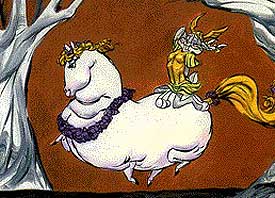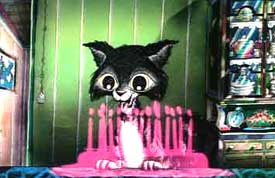A spoof of Disney's Fantasia (1939) pretending to be by a filmmaker who never saw the original, Allegro non Troppo (1977) is a collection of cartoons of varied style & content, built around classical music. In the late '70s this film was a well known standard in the arthouse cinemas of the day, but there followed a couple of decades when it was rarely seen. It's now easily accessible on dvd, with extras, & high time a new generation discovered it.
 The march of Evolution starts from the bubbly dregs of a cola bottle, evolving from single-cell organisms into a line of extinct animals lumbering along in a straight line over a Dali-esque landscape, to the sound of Ravelle's "Bolero," with a primitive ape arising as comic relief. The march of Evolution starts from the bubbly dregs of a cola bottle, evolving from single-cell organisms into a line of extinct animals lumbering along in a straight line over a Dali-esque landscape, to the sound of Ravelle's "Bolero," with a primitive ape arising as comic relief.
It's mesmerizing in its simplicity, & having first seen it when it was new, "Bolero" has never failed to evoke this very image. Similarly has Warner Brothers' What's Opera, Doc? (1957) forever identified the flight of the Valkyries with lyrics sung by Elmer Fudd to Bugs in drag as Brunhilde: "Kill the WAA-bit, kill the WAA-bit."
The huge horse's butt turning slowly into view, the magic helmet, the "sad" demise of Brunhilde -- is it any wonder Chuck Jones is regarded a genius of animated comedy? The "stage" design by Maurice Noble makes it not just funny stuff, but visually poetic.
 Comedy predominates in each cartoon that makes up Allegro non troppo, but heartbreak dominates a haunting piece set to Sibelius's "Valse Triste" about a starving cat with sad Keane eyes wandering the ruins of a house wherein it had once been a happy kitten. Comedy predominates in each cartoon that makes up Allegro non troppo, but heartbreak dominates a haunting piece set to Sibelius's "Valse Triste" about a starving cat with sad Keane eyes wandering the ruins of a house wherein it had once been a happy kitten.
Those two pieces reach a height of perfection as short films in their own right, to stand alongside the best animated shorts of all time. Some of the pieces don't achieve the same level of greatness, but are each effective in one way or another.
"Prelude to the Afternoon of a Faun" portrays the near-exploits of an aging satyr. Antonin Dvorak's "Slavic Dance No. 7" is the soundtrack for a whimsical portrait of an innovative iconoclast striving to live his life with originality, but whom is imitated by an annoyingly devoted community.
Stravinsky's "Firebird" inspired the tale of an alternate dimension's Adam & Eve who never tasted of the forbidden fruit. But the Serpent did, resulting in an hallucinatory nightmare journey.
Set to Vivaldi are the unhappy efforts of a bee striving to collect nectar in the same meadow where human lovers tumble & play.
A closing "collage" of animated fragments & jests is an extended in-joke for fellow cartoonists, parodying the styles of a great number of comix artists from around the world.
Between each cartoon are live-action b/w film interludes featuring a slapstick orchestra of expiring grannies, their cruel conductor, & the enslaved animator (played by comedian Maurizio Nichetti). As humor the live action portions have dated far more than have the cartoons, but remains tolerable.
The animation proper stands heads & tails above the average. Most parents will not regard it as appropriate to children, though I cannot imagine any of it could cause harm.
copyright © by Paghat the Ratgirl
|

 The march of Evolution starts from the bubbly dregs of a cola bottle, evolving from single-cell organisms into a line of extinct animals lumbering along in a straight line over a Dali-esque landscape, to the sound of Ravelle's "Bolero," with a primitive ape arising as comic relief.
The march of Evolution starts from the bubbly dregs of a cola bottle, evolving from single-cell organisms into a line of extinct animals lumbering along in a straight line over a Dali-esque landscape, to the sound of Ravelle's "Bolero," with a primitive ape arising as comic relief.